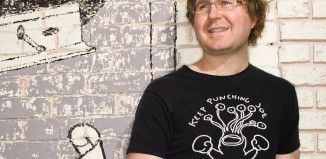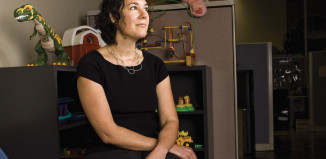Nestled on a quiet, charming street atop a lush green hill in East Austin rests the historic French Legation Museum, a 160-year-old restored mansion built in a classic Anglo-French style. The building has a singular distinction: It is the oldest existing frame structure in Austin. Stretched across a full city block, the building and surrounding property radiate a sense of tranquility; the site’s significant and illustrious history seems to permeate the very air.
Perhaps it is fitting that one of Austin’s most respected architects – who specializes in renovating historic buildings – lives and offices directly across the street. Emily Little says one of her greatest pleasures comes from relaxing in her home’s third-floor nook, where an extraordinary view of the museum inspires her, uplifts her and often takes her breath away.
“When I first moved to this neighborhood, it was like moving to a small town,” says Little, sipping a cup of coffee while sitting at her dining room table, her dog Jim cuddled up at her feet. “It’s so homey, with an open environment and friendly neighbors. I love the Eastside. It’s so much more interesting to me than any other part of town.”
Little spent a year designing and building her beautiful home, a spacious yet cozy dwelling that has many stunning characteristics of a historic structure. The yard is magnificently landscaped with Texas wildflowers and pebble paths, and because the home is adorned with plenty of custom doors and windows, the boundary between indoors and out is easily blurred, giving visitors the soothing feeling that they are enveloped by nature, organic vegetation and fresh air.
Little previously lived in the historic building neighboring her current home that also acts as the office for Clayton Levy Little Architecture, the firm she shares with business partners Paul Clayton and Stephen Levy. A spectacular structure in its own right, the historic home- turned-architecture-office quickly became tight living quarters for Little as business continued to grow.
“It was clear that I needed to figure out some other place to live. But I didn’t want to live in any other part of Austin,” Little says. So she devised a plan that would allow her to build a new home next door, on the same property as her office. “I wanted the home to be really simple. I wanted to explore clean lines because I had lived in an old house for so many years. And I wanted the home to be well-integrated with the site.”
These days, Little enjoys the privacy of her serene and secluded abode and needs walk only a few steps to reach her bustling office space. Little admits that, as an architect, designing and building your own home can be challenging. Faced with many restrictions on how she could build in the given space and a countless number of options from which to choose, Little says she really had to think outside the box, so to speak.
“When I was building this house,” she says, “I was the worst client, of course. I really drove myself crazy trying to nail down all the details. But I’m very happy with the way everything turned out.”
 Born and raised in Austin, Little has an innate sense for the style of architecture that best suits Central Texas. As a master of renovating historic buildings, Little’s talent lies in bringing a structure’s past to life in a manner simultaneously consistent with historical flavor and contemporary appeal. Yet she’s hardly stuck in the past; her newly built projects exude a modern sensibility without adopting the cold, unemotional feel often associated with modern residential and commercial structures.
Born and raised in Austin, Little has an innate sense for the style of architecture that best suits Central Texas. As a master of renovating historic buildings, Little’s talent lies in bringing a structure’s past to life in a manner simultaneously consistent with historical flavor and contemporary appeal. Yet she’s hardly stuck in the past; her newly built projects exude a modern sensibility without adopting the cold, unemotional feel often associated with modern residential and commercial structures.
Maybe that’s why her genius is so celebrated in Austin. In fact, many jump at the opportunity to work with her. Even those who don’t know her by name can appreciate her remarkable architectural work. Chances are, if you live or work in, or have visited Austin, you’ve experienced Little’s brilliance for yourself.
An architect for more than two decades, Little has worked on a multitude of award-winning residential, commercial, multifamily and historic projects in Central Texas. Some of her more popular historic-restoration projects include work on the Katherine Anne Porter House; the 115-year-old Schneider Store, which is the most historically credentialed commercial building in downtown Austin (the structure now houses Lamberts Barbecue); and the 18-acre Texas State Cemetery.
Little’s commercial and multifamily projects include the Inn Above Onion Creek, the popular bed and breakfast in the Hill Country; Cypress Creek Village, a mixed-use and office building in Cedar Park; West Anderson Plaza; the 6-unit Enfield Condos development; and The Orsay, the new 10-story, 90-unit condo development located in downtown Austin.
Though her residential projects are lesser known, they are even more stunning, and include Studio 25, a glass, wood and steel “jewelry box” nestled amongst the foliage in Wimberley; and several homes in the Eastside Agave development, a modernly charming green-built community.
But some of Little’s favorite projects are more altruistic.
“One thing particularly important to me is my volunteer work in the community,” she says. “I have served on many boards in the past, but lately my focus has been on special projects.”
Last year, Little led a team of volunteer architects in converting an Austin middle school into the new Ann Richards School for Young Women Leaders. Another favorite project of Little’s is the minimal yet delightfully whimsical ARFF wall on the shore of Lady Bird Lake. The project is a posthumous tribute to Austin artist Tre Arenz that consists of an undulating concrete wall embedded with heart-shaped rocks and ceramic tiles, a people- and dog-friendly water fountain, and a blue-and-white stripped utility pole, which many Austinites
will recognize as a signature element of Arenz’s work.
Currently, Little is single, and since she doesn’t have a partner, she spends much of her time working. But she professes a love for travel and often jaunts off to faraway lands with friends. She’s fresh from a trip to Antarctica and Japan, and has spent time in Nepal, China and Tibet.
“I love checking out architecture in other parts of the world,” Little says. “It really broadens my horizons and gives me insight in to how other cultures use space.”
Little is unmistakably spending her life doing what she loves and was meant to do, but architecture is not the field in which she began her career. She received a bachelor’s degree in cultural anthropology from the University of Texas and didn’t return to Austin until three years later (after a stint in New York) to get her master’s degree in architecture.
“Architecture school was really fun. It wasn’t the kind of career that many women pursued and I liked that it was kind of unusual,” Little says. “I really took to it.”
After graduation, Little spent three years interning for a couple of small architecture firms and before she knew it, her neighbors and friends were requesting her services for their home remodels. A natural talent, Little excelled early on; her first actual residential project was even featured on the AIA Homes Tour. As such, she never had to make the decision to open her own firm; her business simply grew, quickly evolving to a respected architecture company.
Little’s style as an architect, she says, is often defined by Central Texas’ natural surroundings.
“I like to think that my style is regional and contextual,” she says. “I like architecture that settles in to an environment and can be sculptural. I’m such a fan of the variety of neighborhoods we have in Austin. I get excited when I see a nice infill job and I think the McMansion ordinance is a very good thing; I hate to see the ruination of a neighborhood. I just love that Austin architecture is so eclectic. I hope we can maintain that as the city continues to grow.”




































